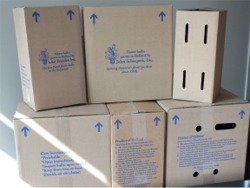 When Orders Are Shipped
When Orders Are Shipped
Based on availability from the annual Dutch harvest, we will ship your order to you so that you may plant your flower bulbs at the proper time for your horticultural zone. The third week in September, we start shipping orders to the coldest horticultural zones across the U.S. first.
If you need your order earlier or later, based on your own personal or staff schedule, just let us know. We can slate your order to ship the week of your choice, from the third week in September through the end of October. We are not able to specify the exact day of shipment, or the exact day of UPS Ground shipment delivery.
Normally, we have 95% of our complete collection in house from the annual Dutch harvest by the third week in September. There are some late-harvested exceptions: Eremurus, Herbaceous Peonies, Lilies and Dutch Amaryllis. We do our best to ship all orders in their entirety. Some may be split-shipped due to these later harvested varieties.
If you need more bulbs to complete a job or if you have an emergency installation, call us by noon Monday through Thursday, and we can ship your order out the same day via UPS Ground. This usually means overnight service within the New York metro area.
Commercial Pickup Scheduling
Pickups may be scheduled for commercial orders in excess of $1,000 to avoid UPS Ground shipping charges. Pickups should be scheduled more than a week in advance. Pickups may be scheduled on Tuesdays, Wednesdays and Thursdays between 1:00 p.m. and 3:00 p.m. All clients picking up orders must return to us in advance a fully completed Connecticut Sales and Use Tax Certificate. Otherwise, we are required to charge Connecticut sales tax which is 6.35%.
Organizing Your Order
If you have numerous clients, we can also organize your order into distinct individual orders by client as long as each order meets the $50 wholesale minimum and adheres to the minimum unit size of each variety. Then, each carton will be identified by client for easy organization during the busy fall season.
 UPS Ground Order Tracking
UPS Ground Order Tracking
When you place your order, provide us with your email address so that United Parcel Service can send you emailed notification of your order shipment and anticipated delivery. You may also track the progress of your order shipment on our home page by clicking on the UPS shipment tracking icon. All you have to do to track your order from our door to yours, is to log in your order number and the destination zip code. Some smaller shipments may be made via UPS Surepost if the billing and shipping addresses are identical.
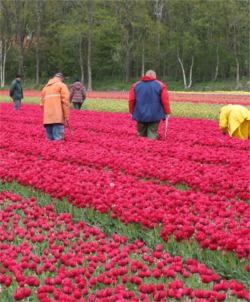 Order Inspection
Order Inspection
The bulbs that we ship to you are inspected throughout the growing season and at harvest time by both Dutch and American agricultural authorities. Once we receive them in our warehouse from the annual Dutch harvest, we inspect them ourselves to make sure they are of the highest quality that you have come to expect from us.
When you receive your order, prior to planting, open all exterior and interior boxes and check your order against the packing slip, and inspect the bulbs. Discard any that are not firm.
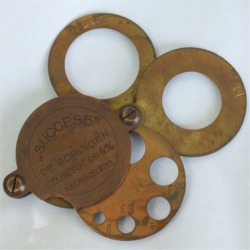 Top-size Bulb Circumference
Top-size Bulb Circumference
Each flower bulb variety produces its own annual top size bulb that is measured at the time of harvest. Each variety description includes its top-size centimeter circumference measurement. A measurement of circumference is taken by measuring around the widest girth of the bulb, as if one were measuring one's waist: not a straight line measurement from left to right. For each variety, only top-size bulbs that are as large as, or larger, than the centimeter size specified do not fall through the holes on a conveyer belt that sorts the bulbs following harvest. You can imagine how this works by taking a look at the age-old bulb measuring device used by Jan Ohms decades ago.
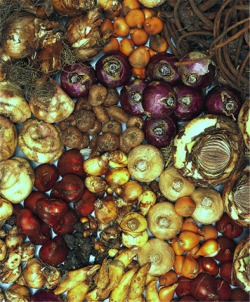 In any one bag of bulbs, you might find some different sizes. Please rest assured that the smallest of the bulbs is at least the size specified for that variety: the others are larger than the size specified: kind of like a bulb bonus.
In any one bag of bulbs, you might find some different sizes. Please rest assured that the smallest of the bulbs is at least the size specified for that variety: the others are larger than the size specified: kind of like a bulb bonus.
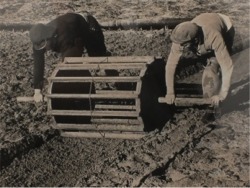 Varying Bulb Appearances
Varying Bulb Appearances
Individual varieties of flower bulbs have different bulb shapes too. Some types of flower bulbs, like Narcissi, may have attached to the 'mother' bulb a baby bulb or two, known as bulblets or offshoots. They need not be broken off from the mother bulb prior to planting. If they break off, you can just plant them at the same depth and space apart as the mother bulb. Other bulbs, like Allium and Fritillaria, may have a 'flat' side. This is how some bulbs multiply, by creating split-aparts.
In days of old, flower bulbs were individually hand dug and harvested. Today, special harvesting equipment is used. Small nicks or scars may be visible from machine harvest but do not affect the bulb's performance. The papery sheaths surrounding some bulbs, like Tulips or Narcissi, may or may not be intact: it has no bearing on the vitality or performance of the bulb. This can occur during harvesting, washing or packaging.
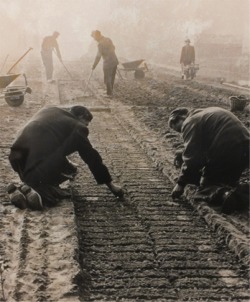
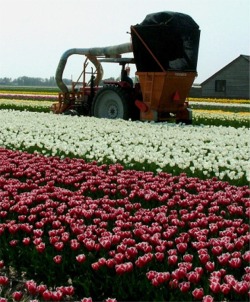 Special Packing Mediums
Special Packing Mediums
Once flower bulbs are harvested, sized, washed and air dried by our fine Dutch growers and export colleagues, each variety is packaged in the best way possible for its long term health and vitality. Our bulbs are packaged in either strong cardboard boxes, mesh bags or air permeable plastic bags.
Some bulbs need some special treatment and require a peat, vermiculite or woody medium to protect them during transit and to retain or wick away moisture. Large Allium, Camassia, most Fritillaria, Muscari armeniacum, Scilla siberica Spring Beauty, Hyacinthoides, Erythronium pagoda and Iris dardanus and cycloglossa are packed in loose wood chips. Fritillaria meleagis is packed in vermiculite. Corydalis solida, Geranium tuberosum and Lily bulbs are packed in peat and nestled into micro-perforated plastic bags as are Herbaceous Peonies rootstocks.
A Firm Bulb Is A Viable Bulb
Our flower bulbs are carefully loaded on to 68°F temperature- and humidity-controlled containers that travel by ship across the Atlantic Ocean. Once they are released from port, the refrigerated containers are trucked to us immediately for inspection and acceptance in our warehouse.
During this process, some varieties, like Tulips or Muscari, may develop a blue-green surface mold, commonly known as a 'transportation mold'. It is a natural phenomenon that occurs when some types of bulbs are out of the soil and exposed to oxygen. As long as the bulb is firm, there is nothing to worry about. This mold is actually extinguished by the lack of oxygen and wicked away by the soil when the bulbs are replanted. If you want to, you may gently remove the mold with a paper towel, or let them air out in the sun for an afternoon.
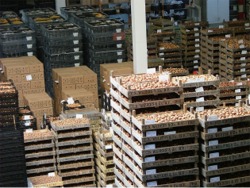 Some bulbs, like Lilies or Hyacinths, may have retained harvest moisture. Occasionally, a bulb may have a thin layer of soft outer scales. This thin layer may be gently rubbed off or aired out in the sun for an afternoon or left as is since the soil will wick the moisture away once planted.
Some bulbs, like Lilies or Hyacinths, may have retained harvest moisture. Occasionally, a bulb may have a thin layer of soft outer scales. This thin layer may be gently rubbed off or aired out in the sun for an afternoon or left as is since the soil will wick the moisture away once planted.
In a nutshell, a firm bulb is a viable bulbs. But if you have any questions about any of your bulbs, just call us.
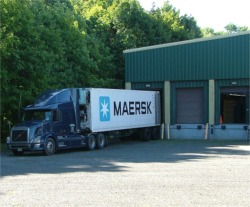 Rare Crop Failures
Rare Crop Failures
In the event of a crop failure of one particular variety, we will make every effort to contact you personally with our recommendations for alternate varieties with similar growing characteristics. We never make automatic substitutions. It does not often occur, but flower bulbs are perishable, natural entities and some are only grown by one nursery in the Netherlands.
Contact Us With Questions or Concerns
Please contact us within ten days of order receipt if there is a problem with any part of your order so that we may rectify with you. (Perishable flower bulb returns are not accepted unless authorized in advance within three days of order receipt. Sorry, but there is a 20% restocking fee for returned orders and for orders canceled after shipment. Shipping and handling charges are not refundable.) If we do not hear from you, we will assume that your bulbs have arrived healthy and are of the high quality that you have come to expect from us.
This might be strange to write, but we take pride in our order packaging. We have designed strong exterior cartons, and strong supportive interior cartons to protect your flower bulbs in transit.
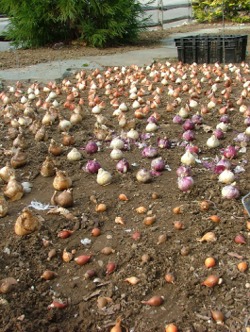 As each order is picked and packed, product bar codes are scanned to make sure that each order is correct and complete. When you check your order against the packing slip, be sure to open each and every interior box. Sometimes, to reduce bulb bouncing in transit, a small bag of Crocus, for example, might be fitted into an interior box with the label of a Tulip, for example. We do our best to keep multiple bags or boxes of individual varieties clustered together to make it less of a big jigsaw puzzle when you receive your order.
As each order is picked and packed, product bar codes are scanned to make sure that each order is correct and complete. When you check your order against the packing slip, be sure to open each and every interior box. Sometimes, to reduce bulb bouncing in transit, a small bag of Crocus, for example, might be fitted into an interior box with the label of a Tulip, for example. We do our best to keep multiple bags or boxes of individual varieties clustered together to make it less of a big jigsaw puzzle when you receive your order.
If you have a large order, we can also work with you in advance to segment your order into individual components of Tulips, Narcissi or Miscellaneous Bulbs, for example, to minimize bulb sorting when you receive your order. Just give us a call.
Store Bulbs Cool and Dry with Good Air Circulation
Until you plant your bulbs, store them in a cool, dry spot (50°F to 70°F) with good air circulation and low humidity, away from heat, frost and strong sunlight. Poor storage conditions may cause bulbs to dry out, or to become moldy.
All flower bulbs must be planted in the fall they are received, after the ground has chilled to around 55°F, normally after a killing frost. Flower bulbs are living, breathing perishable entities that must be nestled back into the soil in order to thrive. Otherwise, they will desiccate without roots, food or water, or rot without soil to wick away moisture.




